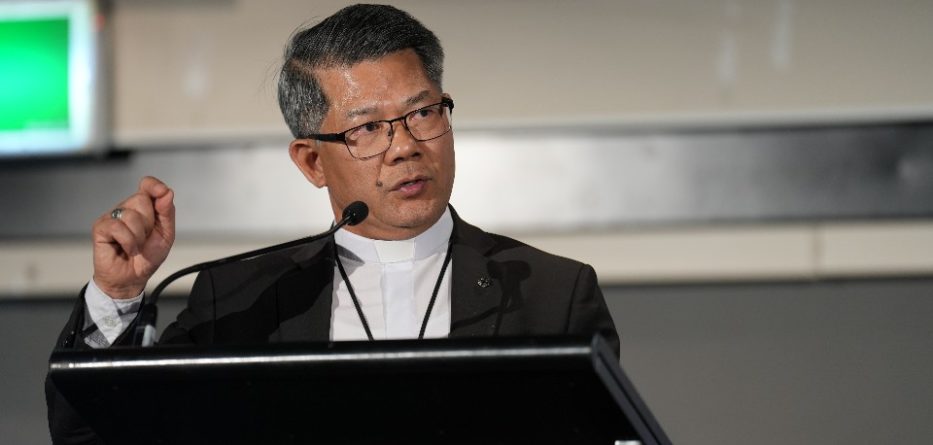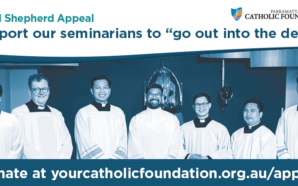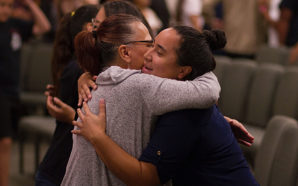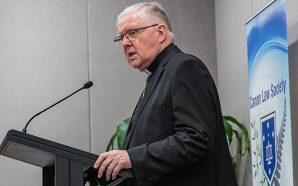Bishop Vincent Long OFM Conv, Bishop of Parramatta
Address to the Catholic Education Diocese of Parramatta Symposium
‘Catholic Education for all, building a culture of dialogue’
Rosehill, NSW
3 November 2022
It is a privilege for me to be speaking to you this morning, conscious that we have celebrated an important milestone of 200 years of Catholic Education in Australia. The early Catholic educators took a prophetic stance in not simply providing affordable quality education to the poor masses but fundamentally in meeting the great cultural challenges of their times.
RELATED: Symposium affirms Catholic faith relevant in today’s world
Catholic education in the Diocese of Parramatta which I am proud to say was where it all began and spread like a good oil to the rest of the country. From its very inception, it was an act of prophetic courage, defiance and an alternative vision of social inclusion. Catholic education did not come to existence because Catholics wanted to create a ghetto. Rather, it came into existence because in the words of Mary McKillop, our pioneers saw a need and decided to do something about it. That unmet need was the plight of the poor, unmarried mothers, the underprivileged and those who could not have afforded a quality education for their children otherwise. So, our pioneers launched into the deep and modelled an inclusive, caring and wholesome way of being together. Catholic education began not so much an academic institution as a community grounded in the Gospel values.
We are privileged to stand on their shoulders and continue to foster their legacy. Like stewards who bring out of their storeroom treasures both old and new, we draw from inspiration from our tradition and also listen to what the Spirit is saying to us in our lived context. Thus, we are alive to the past and responsive to the future. We sit on the old mat in order to weave the new, as an African adage says.
Whether we are pastors, principals, leaders, teachers, parents, guardians and students, we have been called to accompany one another on the journey to wholeness and to lead our learning communities to become critical yeast in critical times. In the footsteps of our pioneers, we are committed to an education that forms young people into men and women committed to the common good, social equity as opposed to individualism and self-interest.
As leaders for mission, we are not merely the keepers of the status quo. Rather, we are catalysts for renewal; we are dreamers of the alternative future. We explore new frontiers and possibilities. Our job is to keep alive not necessarily memories of the way things were but the dangerous memory of Jesus’s life-transforming and socially subversive ethos. For he was the antidote to imperial imagination and practice.
Embracing a synodal model of governance
This conference is an opportunity for us to pause and give gratitude to the past, to live the present with passion, embrace the future with hope. Our conscientization of the signs of the times along with our inherited tradition is a privileged threshold for the future. It is like the precious vantage point of Mount Nebo where Moses who, having surveyed the passage of the Exodus, launched forward to what lay ahead.
Speaking of the new conscientization, was it not a spirit-inspired historic event that we celebrated a few months ago? There have been many post-mortem analyses and reflections. For me, the Australian Plenary Council was a sign of our coming of age and embrace of the synodal paradigm. We embraced a new way of being Church that the Second Vatican Council envisaged. This new way was symbolised by the roundtable at which we sat and met as a community of equals. The emphasis on the superiority of the ordained gave way to an ecclesial communion based on common baptism. Everyone was addressed by our first names. No one’s voice counted more than another’s. There was a profound sense of being together and working together even if we have distinct roles in the Church. The status quo of clerical dominance and lay subservience no longer held sway. We launched into the new era of living the synodal culture of discernment, consensus and decision-making.
I am proud to say that this synodal culture has already been embraced in the Diocese of Parramatta. Two years ago, we undertook the most comprehensive, professional and timely governance review ever taken among the dioceses in Australia. It provided the impetus and a launching pad for a root and branch reform of how the Church in Parramatta should conduct its mission.
While the Governance Review Report contains a series of recommendations for us to discern, endorse and implement, it affirms the progress that has been made. I am particularly pleased that the reviewers recognise that a culture of synodality already exists in the diocese, which they call the ‘Parramatta Way’. It is the way of being Church and doing mission in our diocese. The ‘Parramatta Way’ is, I hope, reminiscent of the way of Jesus, the way of the early Christian community and the way that the Church today, under the leadership of Pope Francis is embracing with renewed vigour. It is not so much innovation or a rupture as a recovery and a recontextualization of tradition.
The Parramatta Way espouses a fundamental collaboration between clergy and laity, the diversity of membership in governance structures and emphasises accountability, transparency and inclusivity. Our ‘Parramatta Way’ is therefore especially lived out in the Curia, Diocesan Pastoral Council, Deanery Councils and the many other ecclesial structures where members of our Catholic community practise synodality, listening, praying and discerning where the Holy Spirit is leading the community today.
Understanding synodality and how it is embedded in ‘the Parramatta Way’ is crucial for understanding why we have chosen to go down the path of incorporation of our education mission. Incorporation in the Church community is a civil governance framework that, properly constituted and formed, is able to reflect an equality of partnership in the mission of the Church that is shared by all members of the People of God through baptism. It is not mere corporatization but the embodiment of synodality. This is truly a momentous leap of faith and a significant milestone in the life of the Diocese as we move decisively towards a synodal way of governance, decision making and mission.
Synodality and Catholic Education
As the Church enters the new era of synodality, we must explore its implications for Catholic education. With Pope Francis, synodality has evolved beyond the exercise of episcopal collegiality to include the totality of the Church. Even more importantly, he has engaged an ecclesiological gear shift with regard to the understanding of revelation and the transmission of the faith.
Since the Council of Trent, revelation was understood as a transmission of the faith in a hierarchically ordered way through the Pope, bishops, priests and faithful -an ecclesial version of a trickle-down economy if you will. According to this mode of revelation, the Spirit was understood to be given to the hierarchy to guarantee the truthfulness of what they teach while in the laity the Spirit was given for their personal sanctification and growth in holiness. The laity were recipients of the faith, often through a series of propositions, rather than active participants. It would not be until the Second Vatican Council that the link between baptism and mission would be restored and accordingly the understanding of revelation would involve the active participation of all the people.
Conciliar teaching on the People of God reveals the fundamental equality of all believers rooted in baptism which makes them sharers in the common priesthood of Christ and confers on them charisms for mission. This baptismal consecration takes precedence over all subsequent consecrations. The pre-conciliar two-states ecclesiology which precludes the laity from pastoral ministry is juxtaposed with a new ecclesiology centred on the dignity and primacy of baptism. Pope Francis would take a step further in Predicate Evangelium by allowing lay people to participate in the governance of the Church.
Vatican II also taught that revelation occurs within the whole People of God and that the working of the Holy Spirit is not only granted to the ordained, but to all the faithful. Dei Verbum, for example, presents revelation in terms of God inviting men and women into fellowship with him. Instead of a package of set doctrines about God, it speaks of the Holy Spirit bringing believers into a deeper understanding of revelation.
This rich trinitarian understanding of revelation implies that there is a need of mutual dialogue and respect of laity and hierarchy, and even more importantly, that a participation of all the faithful is required for discerning the voice of the Holy Spirit. In other words, if revelation occurs within the whole Church and not only through the ordained, then it requires the reconfiguration of the protagonists and the cooperation among all the people of God from the laity to the Pope.
Pope Francis affirms the importance of the sensus fidei in Evangelii Gaudium “all the baptized, whatever their position in the Church or their level of instruction in the faith, are agents of evangelization, and it would be insufficient to envisage a plan of evangelization to be carried out by professionals while the rest of the faithful would be simply passive recipient.” The sensus fidei renders dichotomy of the teaching church and learning church inadequate. A synodal church is a church that listens and the listening is not one-dimensional or linear but mutual because everyone (including bishops and the Pope) has something to learn.
If synodality is constitutive of the Church as it seeks to journey together and enable its members to exercise greater communion, participation and mission, then it is necessary for Catholic education to be in line with the ecclesiology of Vatican II. In other words, it would be inconsistent with our understanding of revelation to involve students as merely passive recipients of information rather than as protagonists.
The relationship between the teacher and student cannot be limited to a linear and one-dimensional approach. Rather, it must be framed in an atmosphere of respectful and mutual dialogue. It is the duty of a caring Catholic community to provide for the holistic development of students as human persons and beloved children of God. Accordingly, the recent Vatican instruction appropriately entitled The Identity of the Catholic School for a Culture of Dialogue remarks:
“The school must be the first social setting, after the family, in which the individual has a positive experience of social and fraternal relationships as a precondition for becoming a person capable of building a society based on justice and solidarity, which are prerequisites for a peaceful life among individuals and peoples. This is possible through a search for truth that is accessible to all human beings endowed with rationality and freedom of conscience as tools useful both to study and in interpersonal relationships.”
Further on, it adds:
“A distinctive feature of its ecclesial nature is that it is a school for all, especially the weakest. This is testified to by the “establishment of the majority of Catholic educational institutions [in response] to the needs of the socially and economically disadvantaged…”
In a society that increasingly sees education as a commodity that can be bought, we must resist being used as vehicles for socio-differentiation and elitism. Catholic schools find their authenticity in the Gospel priorities of respect for human dignity, outreach, inclusion and special concern for young people at risk of being left behind. Ours are not schools that provide education for Catholics only but Catholic education for all.
Our Parramatta Catholic education system has been outstanding in doing just that: as it has built on the work of many religious and lay people over the decades. We are known to be at the cutting edge of innovative, inquiry-based, technology-oriented and above all Gospel-grounded education.
In a sense, every Catholic school community opens its doors to the local community every day – and invites them to join the journey of growth and transformation. Ours is a Christ-centred community that fosters not only intellectual growth, but just as importantly, young people’s emotional and spiritual growth. And if we continue to build on the magnificent legacy we have we will all need much creativity and imagination in the task still ahead of us.
Catholic education for all
As we consider who and what we are in the mirror of the coronavirus pandemic, we can ask, who are we and what do we hope for? How we live in a world of chaos and specifically as Catholic educators, how do we educate and equip young people for the challenges in the 21st century.
We are in a global breakthrough in evolution and if we want a different world, we must become a different people. We have a chance to rewire ourselves for a new existence, but we must begin to live in a new way. We must abandon the old framework of individualism, siloism and the default controllable, manageable and profitable systems that undergird the operations of our society.
It is time to embrace our new reality. I believe that as educators, we have the opportunity to form a new generation that values the common good more than individual success. Just as the Pope calls for a new politics of inclusion in the light of the systemic inequalities in the world, we also need an education that forms young people into men and women of deep empathy, solidarity and communion as opposed to individualism and self-interest.
The coronavirus crisis reveals a world that is fractured. It tells us that the dominant mode of human conquest and dominion is no longer sustainable. The human-centered planet is out of sync with nature and heading to ruins. We may be on top of the food chain, but our survival depends on our partnership with every form of life. We need a radical new way of relating and living that brings harmony and sustainability to all of life. We humans are part of the interconnected cosmic web of creation and we need to live a new paradigm of communion with all that is.
The present crisis can be turned into new horizons of possibility, for us but also beyond us, to future generations and to the world that God loves. Pope Francis said the following in one of his addresses to Catholic educators:
“The greatest failure for an education is to educate within the walls: the walls of selective culture, the walls of a culture of security, the walls of a social class.
We cannot go on like this with a selective type of education. No one should be denied. We must leave the places where we are as educators and go to the outskirts, to the poor.”
Catholic schools find their authenticity in the Gospel priorities of inclusion and special concern for young people at risk of being left behind. We are not schools that provide education for Catholics only but Catholic education for all.
Conclusion
Catholic education is not meant to be a numbers game. It is our substance, and not our size that makes the difference. Hence, this time of diminishment of the institutional church can be a blessing in disguise as it makes us less reliant on ourselves but on the power of God. Diminishment allows us the precious opportunity to identify with the “remnant faithful”, to learn the power of vulnerable trust. It is not a time for cynicism or nostalgia. It is a time for deepening of commitment, of grounding in our core values.
The Church is being reborn in ways beyond the traditional structures. Like the river that has changed its course, we have a choice to make. It is not in yearning for or holding on the known and the familiar but in reimagining the future and venturing into the unknown chaos like the old exodus that we shall find new life.
The paschal rhythm summons us to a discipleship of humility, weakness and vulnerability, of dying and rising in Christ. As the Church, we must die to the old ways of being Church which is steeped in a culture of clerical power, dominance and privilege. We must abandon the old paradigm of a fortress Church which is prone to exclusivity and elitism. We must learn to rise to Christlike way of humility, inclusivity, compassion and powerlessness.
The history of the Church is a journey into chaos, discovery and re-imagination writ-large. Our forebears have known too well that there is never a time to settle into false securities: numbers, prestige, power and influence etc…
Discerning and living the creative power of the Spirit through the rhythm of founding, growth, diminishment, death and refounding have been their strength. Through it all, it is for the sake of a healthier Church and a healthier society that they endeavor to model the way of the God of Jesus.
This pattern is no other than the pattern which is at the heart of the Gospel. Learning to die and to rise is the key our being co-creators of Christ in the mission of transforming lives and relationships that we have been entrusted with.
Teilhard de Chardin once observed: “The only task worthy of our efforts is to construct the future”. As we listen to the Spirit, keep one eye on yesterday and the other on tomorrow, may we reignite the spirit with which our spiritual forebears transformed the world, thus co-creating a future of hope for the people of our time.
Read more about the Catholic Education Diocese of Parramatta Symposium here.








